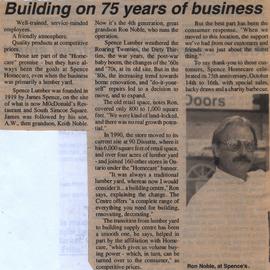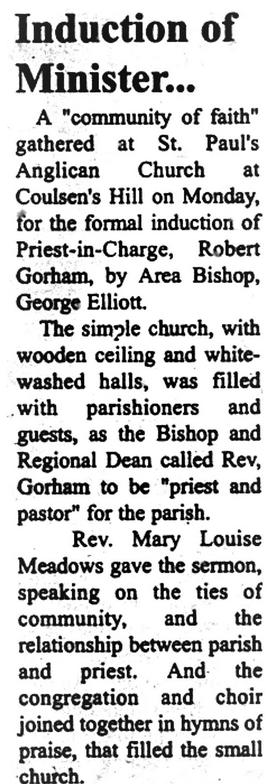Building on 75 years of business - Spence Lumber
- CA BWGPL LHC-Newsp-Arti-PH26592
- Unidad documental simple
- 1990-10
Parte deLocal History Collection
Well-trained, service-minded employees. A friendly atmosphere. Quality products at competitive prices. Those are part of the "Homecare" promise - but they have always been the goals at Spence Homecare, even when the business was primarily a lumber yard. Spence Lumber was founded in 1919 by James Spence, on the site of what is now MacDonald's Restaurant and South Simcoe Square. James was followed by his son, A.W., then grandson, Keith Noble. Now it's the 4th generation, great grandson Ron Noble, who runs the operation. Spence Lumber weathered the Roaring Twenties, the Dirty Thirties, the war years, the post-war baby boom, the changes of the '60s and '70s, at its old site. But in the '80s, the increasing trend towards home renovation, and "do-it-yourself" repairs led to a decision to move, and expand. The old retail space, notes Ron, covered only 800 to 1,000 square feet. "We were kind of land-locked, and there was no real growth potential." In 1900, the store moved to its current site at 90 Dissette,where it has 6,000 square feet of retail space, and over four acres of lumber yard - and joined 160 other stores in Ontario under the "Homecare" banner. "It was always a traditional lumber yard, whereas now I would consider it...a building centre," Ron says, explaining the change. The Centre offers "a complete range of everything you need for building, renovating, decorating." The transition from lumber yard to building supply centre has been a smooth one, he says, helped in part by the affiliation with Homecare, "which gives us volume buying power - which, in turn, can be turned over to the consumer," as a competitive prices. But the best part has been the consumer response. "When we moved to this location, the support we've had from our customers and friends was just about the nicest thing." To say thank-you to those customers, Spence Homecare celebrated its 75th anniversary, October 14th to 16th, with a special sales, lucky draws and a charity barbecue.
Sin título






